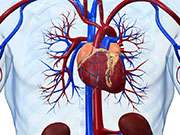Device used in europe promising for refractory angina

(HealthDay)—A stent-like device placed in the coronary sinus may benefit patients with refractory angina, according to a small clinical trial published in the Feb. 5 issue of the New England Journal of Medicine. The Reducer device is already approved in Europe but not yet in the United States.
Shmuel Banai, M.D., director of interventional cardiology at the Tel Aviv Sourasky Medical Center in Israel, and colleagues recruited 104 patients with class 3 or 4 angina who'd failed to improve with medication and could not have the standard invasive procedures. The team randomly assigned half of the patients to have the Reducer device implanted, which involves threading a catheter into the coronary sinus under local anesthesia. The rest of the patients were assigned to a sham procedure, in which the catheter was inserted but no device was implanted.
Over the next six months, 35 percent of patients with the device saw their symptoms improve by at least two angina classes. That compared with 15 percent of the sham-treatment group. Other patients got relief, too. In all, 71 percent of those with the device improved by at least one angina class, versus 42 percent of the sham group. One patient who received the implant suffered a myocardial infarction soon after the procedure. But in general, the treatment appears relatively safe, according to Banai.
It's been estimated that refractory angina affects up to two million people in the United States, according to Christopher Granger, M.D., director of the Cardiac Care Unit at Duke University Medical Center in Durham, N.C., who cowrote an editorial published with the study. Still, larger and longer-term studies are needed, Granger stressed. "This is a well-done study, and it's an important study," he told HealthDay. "But it's still a small study."
Neovasc, the company that markets the device, funded the new research.
More information:
Full Text (subscription or payment may be required)
Editorial (subscription or payment may be required)
Copyright © 2015 HealthDay. All rights reserved.
















